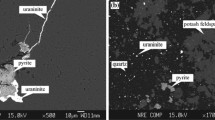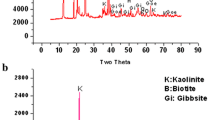Abstract
The effect of four significant variables, namely, pH value, solid–liquid ratio, initial Fe2+, and inoculation percent, on uranium bioleaching was studied using a Box–Behnken design. The results showed that pH was the most effective parameter, followed by the solid–liquid ratio and the inoculation percent, whereas the effect of initial Fe2+ was minimal. The optimum variables for the maximum uranium bioleaching recovery (90.20% ± 0.70%) were as follows: pH, 1.80; solid–liquid ratio, 0.11 (w/v); inoculation percent, 19.20% (v/v); and initial Fe2+, 4.60 g/L. The maximum uranium recovery from the predicted models was 91.40%, which was reliable with the experimental value.








Similar content being viewed by others
References
Wang XG, Liu YJ, Sun ZX, Li J, Chai LY, Min XB, Guo YD, Li P, Zhou ZK (2017) Heap bioleaching of uranium from low-grade granite-type ore by mixed acidophilic microbes. J Radioanal Nucl Chem 314(1):251–258. https://doi.org/10.1007/s10967-017-5406-8
Zmmit CM, Brugger J, Southam G, Reithet F (2014) In situ recovery of uranium—the microbial influence. Hydrometallurgy 150:236–244. https://doi.org/10.1016/j.hydromet.2014.06.003
Abhilash Pandey B D, Ray L (2012) Bioleaching of apatite rich low grade Indian ura-nium ore. Can Metall Quart 51(4):390–402. https://doi.org/10.1179/1879139512Y.0000000024
Abhilash Pandey B D, Singh AK (2013) Comparative performance of uranium biolea-ching from low grade Indian apatite rock in column and bioreactor. Energy Proc 39:20–32. https://doi.org/10.1016/j.egypro.2013.07.188
Choi MS, Cho KS, Kim DS, Ryu HW (2005) Bioleaching of uranium from low grade black schists by Acidithiobacillus ferrooxidans. World J Microbiol Biotechnol 21(3):377–380. https://doi.org/10.1007/s11274-004-3627-9
Tácia CV, Lázaro CS, Isabel CBR, Larissa AMS, Versiane AL (2012) The effects of fluoride and aluminum ions on ferrous-iron oxidation and copper sulfide bioleachin-g with Sulfobacillus thermosulfidooxidans. Biochem Eng J 62(3):48–55. https://doi.org/10.1016/j.bej.2012.01.003
Michael LMR, Klinger CSL, Hamilton CL, Larissa AMS, Versiane AL (2015) Bioleaching of fluoride-bearing secondary copper sulphides: column experiments with Acidithiobacillus ferrooxidans. Chem Eng J 284:1279–1286. https://doi.org/10.1016/j.cej.2015.09.020
Li Q, Sun J, Ding DX, Wang QL, Shi WG, Hu EM, Wang XX, Jiang XY (2017) Characterization and uranium bioleaching performance of mixed iron- and sulfur-oxidizers versus iron-oxidizers. J Radioanal Nucl Chem 314(3):1939–1946. https://doi.org/10.1007/s10967-017-5569-3
Brierley JA, Kuhn MC (2010) Fluoride toxicity in a chalcocite bioleach heap process. Hydrometallurgy 104(3–4):410–413. https://doi.org/10.1016/j.hydromet.2010.01.013
Tavakolia HZ, Abdollahya M, Ahmadi SJ, Darban AK (2017) Enhancing recovery of uranium column bioleaching by process optimization and kinetic modeling. Trans Nonferrous Metal Soc 27(12):2691–2703. https://doi.org/10.1016/S1003-6326(17)60298-X
Eisapour M, Keshtkar A, Moosavian MA, Rashidi A (2013) Bioleaching of uranium in batch stirred tank reactor: process optimization using Box-Behnken design. Ann Nucl Energy 54:245–250. https://doi.org/10.1016/j.anucene.2012.11.006
Liu XY, Chen BW, Chen JH, Zhang MJ, Wen JK, Wang DZ, Ruan RM (2016) Spatial variation of microbial community structure in the Zijinshan commercial copper heap bioleaching plant. Miner Eng 94:76–82. https://doi.org/10.1016/j.mineng.2016.05.008
Jia Y, Sun H, Chen D, Gao H, Ruan R (2016) Characterization of microbial community in industrial bioleaching heap of copper sulfide ore at Monywa mine, Myanmar. Hydrometallurgy 164:355–361. https://doi.org/10.1016/j.hydromet.2016.07.007
Liu X, Chen B, Wen J, Ruan R (2010) Leptospirillum forms a minor portion of the population in Zijinshan commercial non-aeration copper bioleaching heap identified by 16S rRNA clone libraries and real-time PCR. Hydrometallurgy 104(3–4):399–403. https://doi.org/10.1016/j.hydromet.2010.03.024
Liu X, Wu B, Chen B, Wen J, Ruan R, Yao G, Wang D (2010) Bioleaching of chalcocite started at different pH: response of the microbial community to environmental stress and leaching kinetics. Hydrometallurgy 103(1–4):1–6. https://doi.org/10.1016/j.hydromet.2010.02.002
Gutknecht J, Walter A (1981) Hydrofluoric and nitric acid transport through lipid bilayer membranes. BBA Biomembranes 644(1):153–156. https://doi.org/10.1016/0005-2736(81)90071-7
Ruan R, Liu X, Zou G, Chen J, Wen J, Wang D (2011) Industrial practice of a distinct bioleaching system operated at low pH, high ferric concentration, elevated temperature and low redox potential for secondary copper sulfide. Hydrometallurgy 108(1–2):130–135. https://doi.org/10.1016/j.hydromet.2011.03.008
Fatemi F, Arabieh M, Jahani S (2016) Application of response surface methodology to optimize uranium biological leaching at high pulp density. Radiochim Acta 104(4):239–246. https://doi.org/10.1515/ract-2015-2495
Tavakolia HZ, Abdollahya M, Ahmadi SJ, Kdarban A (2017) Kinetics of uranium bioleaching in stirred and column reactors. Miner Eng 111:36–46. https://doi.org/10.1016/j.mineng.2017.06.003
Rashidi A, Roosta-Azad R, Safdari SJ (2014) Optimization of operating parameters and rate of uranium bioleaching from a lowgrade ore. J Radioanal Nucl Chem 301(2):341–350. https://doi.org/10.1007/s10967-014-3164-4
Acknowledgements
This study was financially supported by National Natural Science Foundation of China (No. 51404031).
Author information
Authors and Affiliations
Corresponding author
Additional information
Publisher's Note
Springer Nature remains neutral with regard to jurisdictional claims in published maps and institutional affiliations.
Rights and permissions
About this article
Cite this article
Mo, X., Li, X. & Wen, J. Optimization of bioleaching of fluoride-bearing uranium ores by response surface methodology. J Radioanal Nucl Chem 321, 579–590 (2019). https://doi.org/10.1007/s10967-019-06594-7
Received:
Published:
Issue Date:
DOI: https://doi.org/10.1007/s10967-019-06594-7




